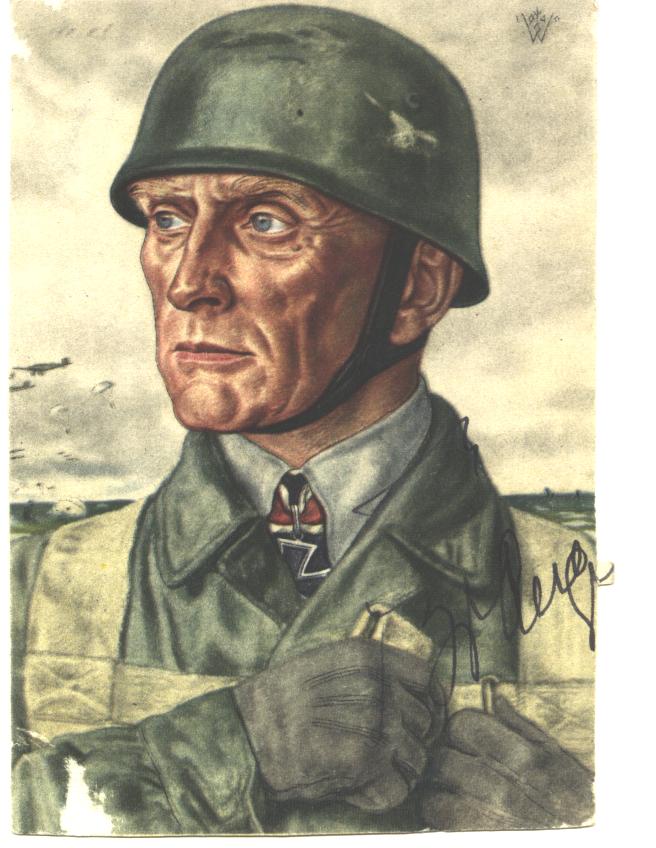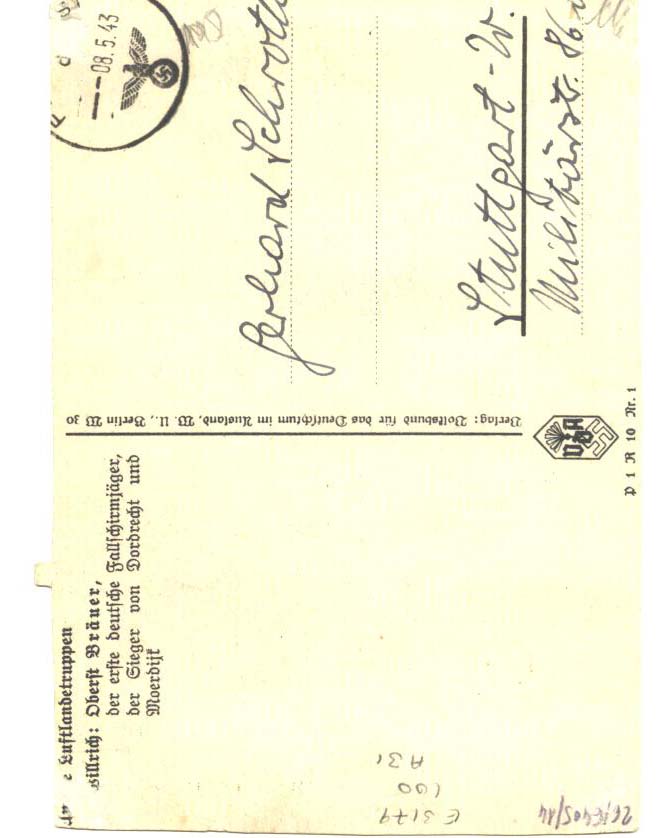

|
~~SOLD~~BRÄUER Bruno
General der Fallschirmtruppe
Bräuer, Bruno
* 04.02.1893 Willmannsdorf, Krs. Jauer
+ 20.05.1947 Athen/Griechenland
Awarded Knights Cross 24.05.1940
as: Oberst Kommandeur FschJägRgt 1
Hanged in Greece
Signed Wartime Willrich Card of Oberst Brauer. The card has been trimmed along the border with the exception of the area which contains the last letter of Brauer’s signature, the result being a small outcrop to accommodate the letter. There is a small area in the lower right hand corner where some tape has lifted some of the surface of the card as well as a small section of the top left and right hand corners as pictured. The card is date stamped 8.5.43.
Although there is some damage to the card the signature is a fine one. Rare to find signature
Bräuer was not similar to the usual German paratrooper, as he was quite short and had a slight stutter. He was also renowned for his gold cigarette case which he can be seen holding in one of the few pictures taken of him on Crete in 1941. Credited for being the most humane commander of fortress Crete, he seemed to look forward to the end of the war and obviously was not sure that Germany would be victorious, as when he talked to Constantinos Mitsotakis after he freed him from jail, he implied that Constantinos would one day play a big part in the running of Greece (he later became Prime Minister) which he would not have said if he thought the country would be under German occupation indefinitely.
Early war
Bräuer led the regiment in Poland, France and the Low Countries, but it was in the Netherlands where he got his reputation for outstanding bravery. His objective was to take two bridges: Moerdijk and Dordrecht. At Moerdijk his second battalion under Captain Prager captured the bridge by dropping two of his companies at each end and storming the bridge, taking it before it could be blown. At Dordrecht the first Battalion, first Fallschirmjäger regiment could only drop one company-the 3rd company under Lieutenant von Brandis. Fierce fighting took place but the bridge remained in Dutch hands and Brandis was killed.
A near by airfield, Waalhaven, was skillfully taken by the third Battalion, first Fallschirmjäger regiment by luring the defenders away from the airfield and then landing in it. As Dutch resistance increased and Dordrecht Bridge still had not been taken Bräuer commandeered Dutch vehicles and, after terrible fighting and incredible bravery from Bräuer, the bridge was taken intact. He received the Knight's Cross for this feat.
Bräuer would also have been involved with the spearhead for Operation Sea Lion, the planned German invasion of Great Britain. While Major Meindl's battalion would be dropped at Hythe, it was planned that Bräuer's regiment would be dropped over Paddlesworth and Etchinghill. Both these units' objectives would be Sandgate and while they were moving to their targets the Luftwaffe would be flying back to France to transport the second wave of paratroopers-Major Stenzler's battalion-who would support the first wave.
Crete
Main article: Battle of Crete
On 20 May 1941 Nazi Germany launched its air attack on Crete. Bräuer was to lead the first Fallschirmjäger regiment and the second battalion, second Fallschirmjäger regiment. His objective was to take the airfield at Heraklion. This was not to be a brilliant success. The second battalion, first Fallschirmjäger regiment, landed on the coast road and came under extreme enemy fire as there was little cover. Bräuer and the first battalion, who had landed to the east of the town quickly moved westwards to try and find any remnants of the second battalion. Eight days later the airfield still had not been taken but as the news that the Germans were advancing across the Island from Maleme reached the Allies, they withdrew to the harbor and were evacuated.
Commander on Crete
In November 1942 Bräuer replaced General Waldemar Andrae as commander on Crete. He tried to make his officers treat the Cretans with more respect. On 25 March, Greek national day, he released 100 Cretan prisoners from jail, one of whom, Constantinos Mitsotakis, would later become Prime Minister of Greece. He quickly got the reputation as hard but fair and the most humane commander of Crete. After German failures at Stalingrad and El Alamein, it was Bräuer who ordered the construction of underground command bunkers, more defenses around Suda Bay and increased ammunition stocks. However, in 1944 General Friedrich-Wilhelm Müller, renowned for his brutality when commander of the 22nd Infantry Division, replaced Bräuer as Commander of Fortress Crete.
9th Paratroopers
In January 1945 the German 9th Parachute Division was formed under Bräuer. It had only five battalions. It was mainly made up of Luftwaffe ground forces and not the battle-hardened Fallschirmjäger Hermann Göring had boasted of.
In January 1945 two of his battalion were encircled by the first Ukrainian front in Breslau where it was destroyed. The rest of the division retreated all the way back to the Seelow Heights where it dug in and prepared to defend against an imminent Russian Offensive. Due to the fact that its troops had seen hardly any action many were uncontrollable when the Russian barrage began. It did not take long before the line had almost completely collapsed and many of Bräuer’s men began to desert. Bräuer was so tired that he suffered a nervous collapse and was relieved of his command.
Execution
Along with General Friedrich-Wilhelm Müller, he was first to stand trial in Athens for committing atrocities on Crete. He was accused of the death of 3,000 Cretans, massacres, systematic terrorism, deportation, pillage, wanton destruction, torture and ill treatment[1]. He was sentenced to death on 9 December 1946. Bräuer was shot at 5 o'clock on the 20 May 1947 on the anniversary of the invasion of Crete. Antony Beevor describes him as 'a truly unfortunate man'.[1]
Burial
Years later the association of German Airborne troops requested that his body be moved to Crete and buried on hill 107 with all of the other German troops killed on the island during the invasion and the occupation. He was buried by George Psychoundakis, the writer of the Cretan runner. His grave can be found in the far left corner of the cemetery next to an unknown soldier
Information from From Wikipedia, the free encyclopedia
Price: $0.00
Please contact us before ordering to confirm availability and shipping costs.
Buy now with your credit card
other ways to buy
|


